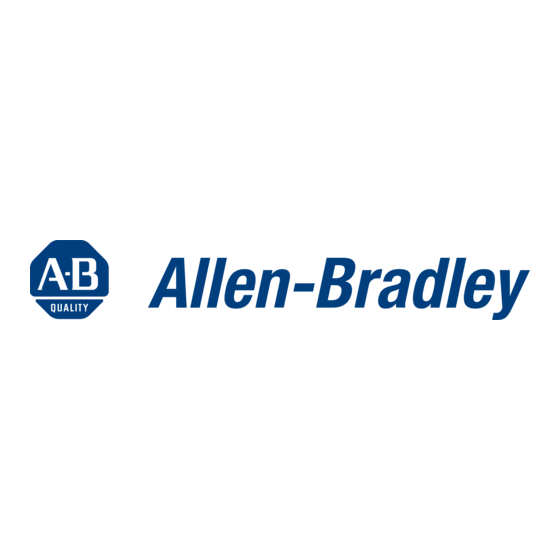
Table of Contents
Advertisement
Quick Links
Advertisement
Table of Contents

Summary of Contents for Allen-Bradley 1771-SF1
- Page 1 Allen Bradley User Servo Interface Module Manual (Cat. No. 1771-SF1)
-
Page 2: Table Of Contents
Table of Contents Introduction ........Description . -
Page 3: Introduction
Chapter Introduction Description The Allen-Bradley Servo Interface Module (Cat. No. 1771-SF1) when used with the Micro Controller (Cat. No. 1771-UC1) can control single axis positioning systems such as found in machine tool applications. When combined with a single motor variable speed drive package and a full quadrature encoder, this microprocessor-controlled servo drive system (Figure 1.1) can be programmed to cycle through precise speed and... -
Page 4: User Considerations
Chapter 1 Introduction User Considerations Operating features described in this manual must be totally programmed in the user software (Z-80A opcodes) of the accompanying micro controller. The servo interface module has the capability to perform as described, provided that the software of the micro controller has been completely developed. -
Page 5: Component Interfacing, Module Preparation, And Installation
Chapter Component Interfacing, Module Preparation, and Installation General This chapter describes the necessary characteristics of user-provided components, preparation and installation of the module and wiring considerations. Refer to the Micro Controller Users Manual (Publication No. 1771-6.5.5) for installation of the micro controller module. Component Interfacing The servo interface module must be compatible with other components of the control system, including the differential line drivers, shaft encoder... -
Page 6: Isolation
Chapter 2 Component Interfacing, Module Preparation, and Installation TTL Source Current = 7.9mA @ 2.4V +10 to -10V DC analog output for forward or reverse proportional motor speed control. Isolation None of the terminals of the servo interface module are protected against misapplication of AC, DC, or reverse DC. -
Page 7: Cable Recommendations
Chapter 2 Component Interfacing, Module Preparation, and Installation Figure 2.1 Typical Connection Diagram Servo Interface Module Field Wiring Arm Channel A Full Differential Channel A Quadrature Line Encoder Driver Channel B Channel B Marker Marker Drive Current Inhibit Amplifier On/Off Servo Analog Control, + 10V Amplifier... -
Page 8: Module Preparation
Chapter 2 Component Interfacing, Module Preparation, and Installation The common terminal of the servo interface module should not be used for the shield connection. This terminal is a common with respect to the analog output, TTL outputs and pull-up resistors on the differential inputs. WARNING: Do not use the common terminal of the servo interface module field wiring arm for the shield connection. -
Page 9: Marker 3
Chapter 2 Component Interfacing, Module Preparation, and Installation Figure 2.2 Example Encoder Diagram (250 Line) Encoder Channel A Output Channel B Counts Marker Pulse Decoded at 360 o Quadrature on the Multiplier Module Single Encoder Line 250 Lines for one rotation (360 10403 Figure 2.3 Burg Pin Jumper Selection... -
Page 10: Module Installation
8-Bit Analog Input Module (Cat. No. 1771-1E) Encoder/Counter Module (Cat. No. 1771-IJ/IK) CAUTION: The Servo Interface Module (Cat. No. 1771-SF1) will operate only when paired with the Micro Controller (Cat. No. 1771-UC1). -
Page 11: Keying
Chapter 2 Component Interfacing, Module Preparation, and Installation Keying Plastic keying bands shipped with each I/O chassis provide an easy method for keying and I/O slot to accept only one type of module. Use of the keying bands is strongly recommended. The module is slotted in two places on its rear edge. -
Page 12: Specifications
Chapter 2 Component Interfacing, Module Preparation, and Installation Specifications Counter Analog Output (Single Channel to Servo Input Amplifier) Differential 10V to + 9.995V Full quadrature encoder 5mA to +5mA max. Counter Range Max. Cable Distance 0 255 40 ft. encoder input Marker input is latched and 40 ft. -
Page 13: Programming And Operation
Chapter Programming and Operation General The servo interface module controls the operation of a single motor servo drive package in accordance with commands received from the micro controller. Outputs to the servo amplifier of the drive package include: -10.000 to 9.995V analog output signal for proportional motor speed and direction control. - Page 14 Chapter 3 Programming and Operation lower 11 bits to the 0 to 10V DC analog output. Bit 12 designates the sign + or - for forward or reverse motion. The resolution of the digital-to-analog conversion is +10V/2048 bits or approximately 4.883 mV/bit.
-
Page 15: Control Byte (Servo Motor Amplifier Inhibit)
Chapter 3 Programming and Operation Table 3.A DAC Input/Output Sign Bit Input Bit Pattern Analog Output Voltage 111 1111 1111 10.000V 111 1111 1110 9.995V 111 1111 1100 9.990V 000 0000 0011 19.5mV 000 0000 0010 14.6mV 000 0000 0001 9.7mV 000 0000 0000 4.9mV... -
Page 16: Encoder Counter Values (Position Pulses)
Chapter 3 Programming and Operation A write instruction to memory location 600FH latches these bits. DSEN Line 17 enables the transfer from the servo interface module. The control byte is reset at power-up or whenever the data byte reset command is programmed. -
Page 17: Marker
Chapter 3 Programming and Operation Marker A low = TRUE signal is transmitted to status port bit 0 after the marker signal is latched by the servo interface module for each completed revolution of the encoder shaft. A write instruction to 600AH will reset this latched output. - Page 18 Chapter 3 Programming and Operation Table 3.B Servo Control Features Control Function Memory Address DSEN Line Comments DAC Data, MSBY 600EH Write 8 bit byte DAC Data, LSBY 600DH Write Upper 4 bits of byte Target Value Preset 600CH Write 0 255 in binary Control Byte...






Need help?
Do you have a question about the 1771-SF1 and is the answer not in the manual?
Questions and answers